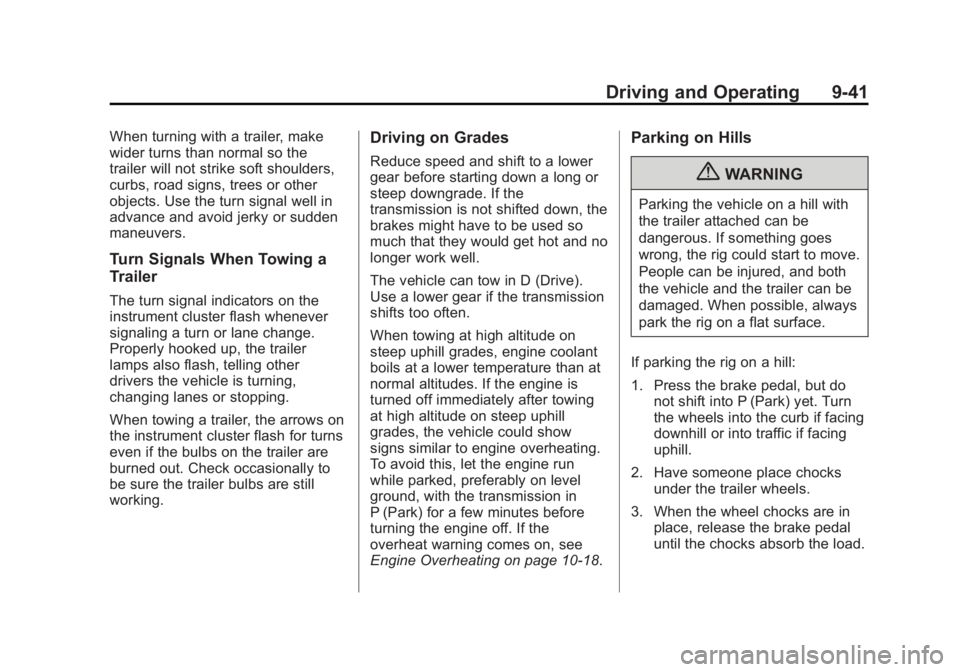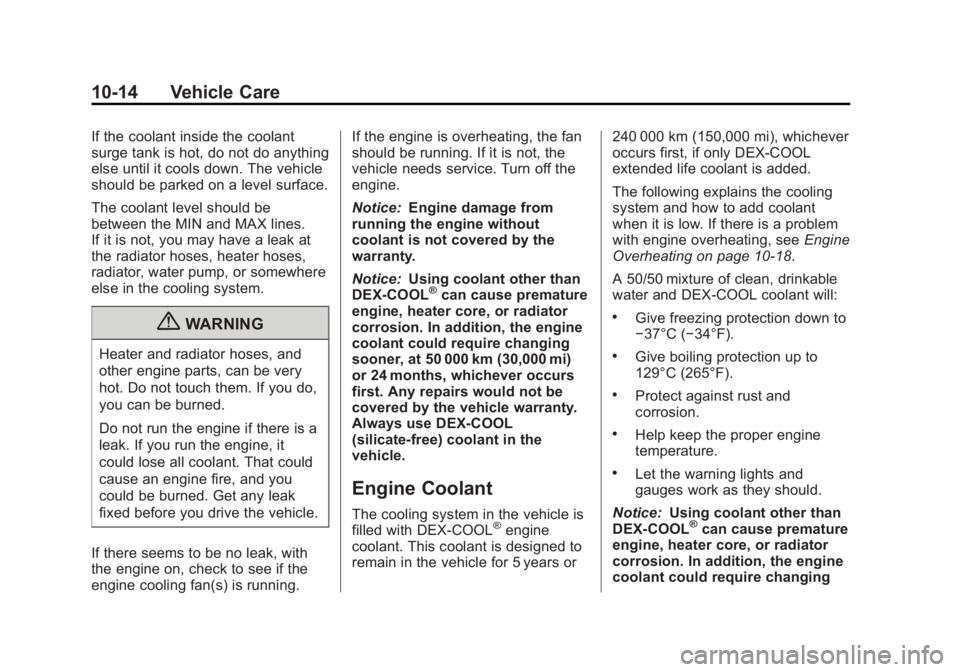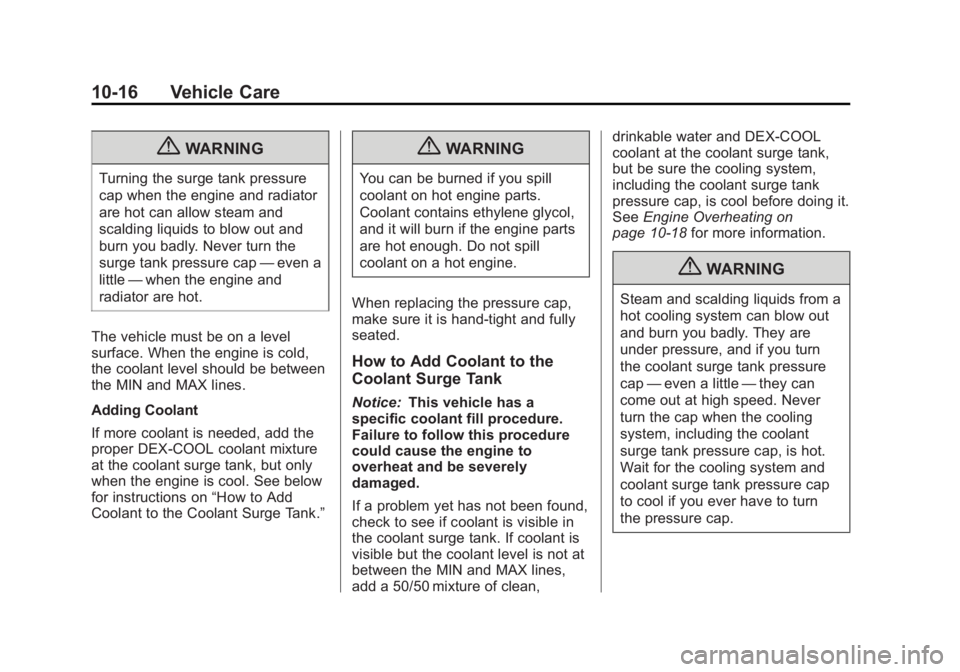2013 CHEVROLET CAPTIVA SPORT coolant level
[x] Cancel search: coolant levelPage 120 of 374

Black plate (24,1)Chevrolet Captiva Sport Owner Manual - 2013 - crc - 11/12/12
5-24 Instruments and Controls The buttons are the trip/fuel, vehicle
information, customization, and set/
reset buttons. The button functions
are detailed in the following pages.
3 (Trip/Fuel): Press this button
to display the odometer, trip
odometer, fuel range, average
economy, fuel used, and elapsed
time. Some vehicles also display
instantaneous economy. The
compass and outside temperature
will also be shown in the display.
The temperature will be shown
in °C or °F depending on the units
selected.
T (Vehicle Information): Press
this button to display the oil life, rear
park assist, units, tire pressure
readings and tire pressure sensor
learning for vehicles with the Tire
Pressure Monitor System (TPMS),
compass zone setting, compass
recalibration on vehicles with this
feature, coolant temperature, and
battery voltage. U (Customization): Press this
button to customize the feature
settings on the vehicle. See Vehicle
Personalization on page 5 ‑ 36 for
more information.
V (Set/Reset): Press this button to
set or reset certain functions and to
turn off or acknowledge messages
on the DIC.
Trip/Fuel Menu Items
3 (Trip/Fuel): Press this button
to scroll through the following menu
items:
Odometer
Press
3 until ODOMETER
displays. This display shows the
distance the vehicle has been
driven in either kilometers (km) or
miles (mi). Pressing the trip
odometer reset stem will also
display the odometer.
To switch between metric and
English measurements, see “ Units ”
later in this section. Trip Odometer
Press
3 until TRIP A or TRIP B
displays. This display shows the
current distance traveled in either
kilometers (km) or miles (mi) since
the last reset for the trip odometer.
Pressing the trip odometer reset
stem will also display the trip
odometer.
Each trip odometer can be reset to
zero separately by pressing
V while
the trip odometer is displayed. You
can also reset the trip odometer
while it is displayed by pressing and
holding the trip odometer
reset stem.
Fuel Range
Press
3 until RANGE displays.
This display shows the approximate
number of remaining kilometers (km)
or miles (mi) the vehicle can be
driven without refueling. This display
will show LOW if the fuel level
is low.
Page 229 of 374

Black plate (41,1)Chevrolet Captiva Sport Owner Manual - 2013 - crc - 11/12/12
Driving and Operating 9-41When turning with a trailer, make
wider turns than normal so the
trailer will not strike soft shoulders,
curbs, road signs, trees or other
objects. Use the turn signal well in
advance and avoid jerky or sudden
maneuvers.
Turn Signals When Towing a
Trailer The turn signal indicators on the
instrument cluster flash whenever
signaling a turn or lane change.
Properly hooked up, the trailer
lamps also flash, telling other
drivers the vehicle is turning,
changing lanes or stopping.
When towing a trailer, the arrows on
the instrument cluster flash for turns
even if the bulbs on the trailer are
burned out. Check occasionally to
be sure the trailer bulbs are still
working. Driving on Grades Reduce speed and shift to a lower
gear before starting down a long or
steep downgrade. If the
transmission is not shifted down, the
brakes might have to be used so
much that they would get hot and no
longer work well.
The vehicle can tow in D (Drive).
Use a lower gear if the transmission
shifts too often.
When towing at high altitude on
steep uphill grades, engine coolant
boils at a lower temperature than at
normal altitudes. If the engine is
turned off immediately after towing
at high altitude on steep uphill
grades, the vehicle could show
signs similar to engine overheating.
To avoid this, let the engine run
while parked, preferably on level
ground, with the transmission in
P (Park) for a few minutes before
turning the engine off. If the
overheat warning comes on, see
Engine Overheating on page 10 ‑ 18 .Parking on Hills
{ WARNINGParking the vehicle on a hill with
the trailer attached can be
dangerous. If something goes
wrong, the rig could start to move.
People can be injured, and both
the vehicle and the trailer can be
damaged. When possible, always
park the rig on a flat surface.
If parking the rig on a hill:
1. Press the brake pedal, but do
not shift into P (Park) yet. Turn
the wheels into the curb if facing
downhill or into traffic if facing
uphill.
2. Have someone place chocks
under the trailer wheels.
3. When the wheel chocks are in
place, release the brake pedal
until the chocks absorb the load.
Page 248 of 374

Black plate (14,1)Chevrolet Captiva Sport Owner Manual - 2013 - crc - 11/12/12
10-14 Vehicle Care If the coolant inside the coolant
surge tank is hot, do not do anything
else until it cools down. The vehicle
should be parked on a level surface.
The coolant level should be
between the MIN and MAX lines.
If it is not, you may have a leak at
the radiator hoses, heater hoses,
radiator, water pump, or somewhere
else in the cooling system.
{ WARNINGHeater and radiator hoses, and
other engine parts, can be very
hot. Do not touch them. If you do,
you can be burned.
Do not run the engine if there is a
leak. If you run the engine, it
could lose all coolant. That could
cause an engine fire, and you
could be burned. Get any leak
fixed before you drive the vehicle.
If there seems to be no leak, with
the engine on, check to see if the
engine cooling fan(s) is running. If the engine is overheating, the fan
should be running. If it is not, the
vehicle needs service. Turn off the
engine.
Notice: Engine damage from
running the engine without
coolant is not covered by the
warranty.
Notice: Using coolant other than
DEX-COOL ®
can cause premature
engine, heater core, or radiator
corrosion. In addition, the engine
coolant could require changing
sooner, at 50 000 km (30,000 mi)
or 24 months, whichever occurs
first. Any repairs would not be
covered by the vehicle warranty.
Always use DEX-COOL
(silicate-free) coolant in the
vehicle.
Engine Coolant The cooling system in the vehicle is
filled with DEX-COOL ®
engine
coolant. This coolant is designed to
remain in the vehicle for 5 years or 240 000 km (150,000 mi), whichever
occurs first, if only DEX-COOL
extended life coolant is added.
The following explains the cooling
system and how to add coolant
when it is low. If there is a problem
with engine overheating, see Engine
Overheating on page 10 ‑ 18 .
A 50/50 mixture of clean, drinkable
water and DEX-COOL coolant will: .
Give freezing protection down to
− 37°C ( − 34°F). .
Give boiling protection up to
129°C (265°F). .
Protect against rust and
corrosion. .
Help keep the proper engine
temperature. .
Let the warning lights and
gauges work as they should.
Notice: Using coolant other than
DEX-COOL ®
can cause premature
engine, heater core, or radiator
corrosion. In addition, the engine
coolant could require changing
Page 250 of 374

Black plate (16,1)Chevrolet Captiva Sport Owner Manual - 2013 - crc - 11/12/12
10-16 Vehicle Care
{ WARNINGTurning the surge tank pressure
cap when the engine and radiator
are hot can allow steam and
scalding liquids to blow out and
burn you badly. Never turn the
surge tank pressure cap — even a
little — when the engine and
radiator are hot.
The vehicle must be on a level
surface. When the engine is cold,
the coolant level should be between
the MIN and MAX lines.
Adding Coolant
If more coolant is needed, add the
proper DEX-COOL coolant mixture
at the coolant surge tank, but only
when the engine is cool. See below
for instructions on “ How to Add
Coolant to the Coolant Surge Tank. ”{ WARNINGYou can be burned if you spill
coolant on hot engine parts.
Coolant contains ethylene glycol,
and it will burn if the engine parts
are hot enough. Do not spill
coolant on a hot engine.
When replacing the pressure cap,
make sure it is hand-tight and fully
seated.
How to Add Coolant to the
Coolant Surge Tank Notice: This vehicle has a
specific coolant fill procedure.
Failure to follow this procedure
could cause the engine to
overheat and be severely
damaged.
If a problem yet has not been found,
check to see if coolant is visible in
the coolant surge tank. If coolant is
visible but the coolant level is not at
between the MIN and MAX lines,
add a 50/50 mixture of clean, drinkable water and DEX-COOL
coolant at the coolant surge tank,
but be sure the cooling system,
including the coolant surge tank
pressure cap, is cool before doing it.
See Engine Overheating on
page 10 ‑ 18 for more information.
{ WARNINGSteam and scalding liquids from a
hot cooling system can blow out
and burn you badly. They are
under pressure, and if you turn
the coolant surge tank pressure
cap — even a little — they can
come out at high speed. Never
turn the cap when the cooling
system, including the coolant
surge tank pressure cap, is hot.
Wait for the cooling system and
coolant surge tank pressure cap
to cool if you ever have to turn
the pressure cap.
Page 252 of 374

Black plate (18,1)Chevrolet Captiva Sport Owner Manual - 2013 - crc - 11/12/12
10-18 Vehicle Care 4. With the coolant surge tank
pressure cap off, start the
engine and let it run until the
upper radiator hose can be felt
getting hot. Watch out for the
engine cooling fan.
By this time, the coolant level
inside the coolant surge tank
may be lower. If the level is
lower, add more of the proper
DEX-COOL coolant mixture to
the coolant surge tank until the
level reaches between the MIN
and MAX lines.
5. Replace the pressure cap. Be
sure the pressure cap is
hand-tight.
Check the level in the surge tank
when the cooling system has cooled
down. If the coolant is not at the
proper level, repeat Steps 1 – 3 and
reinstall the pressure cap. If the
coolant still is not at the proper level
when the system cools down again,
see the dealer. Engine Overheating There is a coolant temperature
warning light on the instrument
panel. See Engine Coolant
Temperature Warning Light on
page 5 ‑ 20 .
If Steam is Coming from the
Engine
{ WARNINGSteam from an overheated engine
can cause serious injury, even if
the hood is opened just a little.
Stay away from the engine if
steam is seen or heard coming
from it. Just turn it off and get
everyone away from the vehicle
until it cools down. Wait until there
is no sign of steam or coolant
before opening the hood.
If driving continues when the
engine is overheated, the liquids
in it can catch fire. Someone
(Continued) WARNING (Continued) could get badly burned. Stop the
engine if it overheats, and get out
of the vehicle until the engine has
cooled.
Notice: Driving the vehicle when
there is no coolant in the coolant
overflow recovery bottle, can
badly damage the engine. The
costly repairs would not be
covered by the vehicle warranty.
If No Steam is Coming from
the Engine If there is an engine overheat
warning, but no steam can be seen
or heard, the problem may not be
too serious. Sometimes the engine
can get a little too hot when the
vehicle: .
Climbs a long hill on a hot day. .
Stops after high-speed driving.
Page 317 of 374

Black plate (3,1)Chevrolet Captiva Sport Owner Manual - 2013 - crc - 11/12/12
Service and Maintenance 11-3
Maintenance
Schedule Owner Checks and Services At Each Fuel Stop .
Check the engine oil level. See
Engine Oil on page 10 ‑ 8 .
Once a Month .
Check the tire inflation
pressures. See Tire Pressure on
page 10 ‑ 43 ..
Inspect the tires for wear. See
Tire Inspection on page 10 ‑ 49 ..
Check the windshield washer
fluid level. See Washer Fluid on
page 10 ‑ 20 . Engine Oil Change When the CHANGE ENGINE OIL
SOON message displays, have the
engine oil and filter changed within
the next 1 000 km/600 mi. When the
CHANGE ENGINE OIL NOW
message displays, have the engine
oil and filter changed as soon as
possible. If driven under the best
conditions, the engine oil life system
might not indicate the need for
vehicle service for more than a year.
The engine oil and filter must be
changed at least once a year and
the oil life system must be reset.
Your trained dealer technician can
perform this work. If the engine oil
life system is reset accidentally,
service the vehicle within 5 000 km/
3,000 mi since the last service.
Reset the oil life system when the
oil is changed. See Engine Oil Life
System on page 10 ‑ 10 . Tire Rotation and Required
Services Every 12 000 km/
7,500 mi Rotate the tires, if recommended for
the vehicle, and perform the
following services. See Tire
Rotation on page 10 ‑ 49 . .
Check engine oil level and oil
life percentage. If needed,
change engine oil and filter, and
reset oil life system. See Engine
Oil on page 10 ‑ 8 and Engine Oil
Life System on page 10 ‑ 10 . .
Check engine coolant level. See
Engine Coolant on page 10 ‑ 14 . .
Check windshield washer fluid
level. See Washer Fluid on
page 10 ‑ 20 . .
Visually inspect windshield wiper
blades for wear, cracking,
or contamination. See Exterior
Care on page 10 ‑ 72 . Replace
worn or damaged wiper blades.
See Wiper Blade Replacement
on page 10 ‑ 25 .